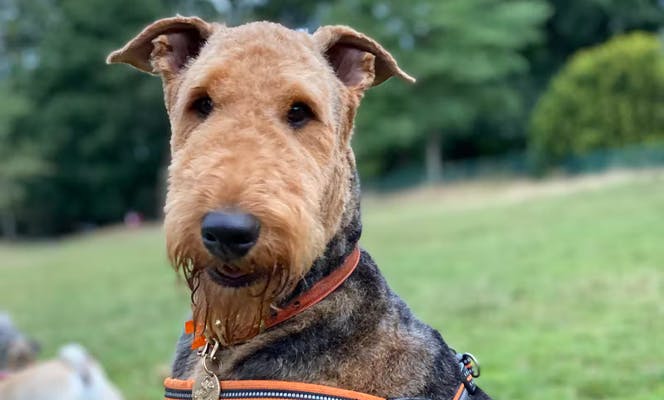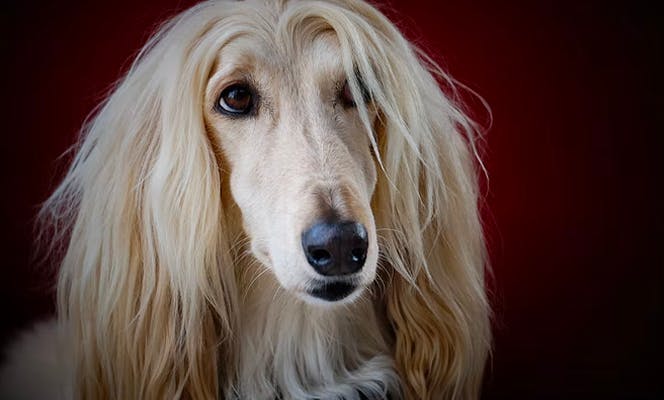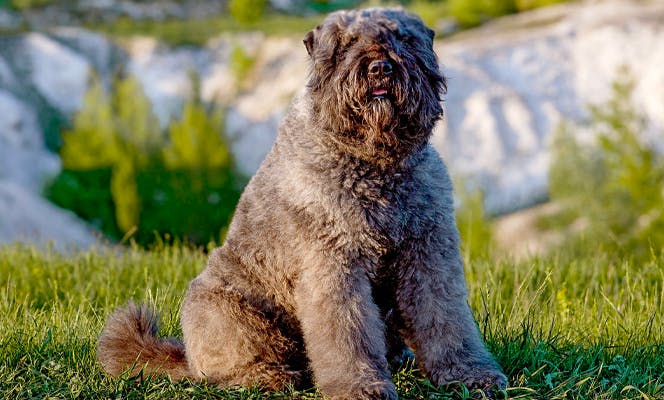Hypoallergenic Large Dogs
Large dogs that are hypoallergenic include poodles and terriers, as well as many other breeds of dog that shed very little. In truth, all dogs shed from time to time, so there is no such thing as a completely allergen-free canine. The good news for allergy-suffering dog lovers is that a low-shedding breed can put dog ownership back on the table! That’s because with less shedding comes much less dander, which is the real culprit of your runny nose and itchy skin.
If you have been dreaming of bringing home a great big dog to become your new best friend but are worried about allergies or piles of fur on the furniture, you’re in luck. Many breeds have fur that is much less likely to cause you any annoyance. Choose hypoallergenic large dogs from any of the breeds listed below and grooming will be minimal, leaving plenty of time for fun and cuddles with your newest family member.
Best Large Hypoallergenic Dogs
There are many wonderful features of hypoallergenic large dogs—aside from the obvious! Generally speaking, large dogs are easier to train than their smaller cousins, which means you’ll have a quicker time teaching yours everything it needs to know. Big dogs are also classic family dogs, thanks to their generally calm and affectionate personalities. Some hypoallergenic large dogs are even well-suited to apartment life, which is great news for potential owners who worry they don’t have the space required for a big pet.
Doodle Breeds

Doodles, or doodle dogs, are dogs that have one purebred poodle parent and one parent of another pure breed. For example, a poodle and a schnauzer make a schnoodle, while a poodle and a Saint Bernard make a Saint berdoodle. The first doodle dogs were bred in the 1980s, and today there are more than 40 different types.
Doodle breeds are known for their soft, curly fur, which comes from their poodle heritage. These loveable dogs are also famous for their lovely disposition. Doodles make excellent family pets since they can adapt to a variety of situations, including city life, country life, outdoor adventures, and relaxing at home.
Poodles tend to be affectionate, and charming, and their doodle relatives are no exception! Popular doodle breeds include the goldendoodle, the Labradoodle, and the Shih Poo (bred from a Shih Tzu and a poodle.) The larger the parent breeds of doodle dogs, the larger the puppies. Large doodles include the great Danoodle (poodle and Great Dane), the standard Bernedoodle (poodle and Bernese Mountain dog) and the Newfypoo (Newfoundland poodle and standard poodle.)
These dogs are handsome, intelligent, and often found working as therapy animals in hospitals and care homes. They have a clever, curious and family-friendly personality that shines through regardless of size, coloring or home environment.
Standard Poodle

Poodles are available in three sizes: standard, miniature, and toy. Standard poodles should stand more than 15 inches tall at the shoulder; miniatures are 15 inches or less; and toy poodles are no more than 10 inches in height. The structure and proportions of all three types are identical.
Poodles are versatile dogs who are enthusiastic, agile, and wickedly smart. Underneath the curly, low allergen coat you’ll find a beautiful and active friend. Poodles love sports, and are regularly found competing in agility and tracking events. They also love to play in the water, since they were originally bred to retrieve ducks and other game birds. In fact, some modern duck hunters still use poodles as part of their hunting team. If you or your family members spend a lot of time in the water, a poodle just might be the perfect dog to add to the household.
Training will go easily if you remember to engage your poodle with plenty of activity-based learning. These are smart dogs who thrive on human attention and want to be as involved in your life as possible. Adopt a poodle and you’ll never have an excuse to be bored again!
Giant Schnauzer
The giant schnauzer is a larger and totally proportionate version of the standard schnauzer, complete with that classic forward-leaning schnauzer stance. These dogs have a strong and powerful body, and weigh up to 48 kilograms. Unlike the poodle and its related breeds, the schnauzer has a double coat with a soft underlayer and a wiry top layer. Evolved to protect the dog from cold winters in the European Alps, this fur is nevertheless very hypoallergenic.
You’ll recognize a schnauzer—giant or otherwise—by its distinctive haircut. Owners and groomers prefer to trim the schnauzer so that its fur resembles a beard and thick brows, making for a very distinguished-looking dog. These dogs need a bath every 2-4 weeks, but their overall grooming needs are relatively little. That classic haircut will need shaping just a few times a year.
As for personality, the giant schnauzer is brave and very loyal to its family. It can be a bit shy with strangers and assertive towards other dogs. Highly energetic, this may not be the right family pet for households with very young and small children, simply because schnauzers love to jump and play. On the other hand, these dogs are a perfect choice as a partner for hiking and adventuring.
Airedale Terrier

The Airedale terrier originally comes from the River Aire valley region of Yorkshire, England. These dogs are also called Bingley or Waterside terriers, and are the largest terrier of all the dozens of types. They weigh up to 29 kilograms and stand as high as 61 centimeters at the shoulder.
Airedale terriers are friendly and outgoing, as well as curious and intelligent. They love to be around their human family but are not usually kind company for other dogs or cats. Airedales are bright and attentive, but they can be a little bossy towards other dogs. Small dogs can sometimes prove to be an exception to this anti-social tendency. That said, these giant terriers are wonderful companions for children. They are also naturally alert and make great watchdogs of the family home.
A very large and high-energy dog, the Airedale terrier is not very well-suited for apartment living but can handle a smaller living space if it gets plenty of play and exercise outside. Too much time confined in a small indoor area can make these dogs antsy and prone to getting into trouble.
Afghan Hound

The Afghan hound is an elegant breed characterized by its little head and long, silky fur. The Afghan’s pointed face and long, floppy ears frame a set of curious and caring brown eyes and a black nose. Their coats are usually gold, brown, white or black. That long, luxurious coat sheds relatively little, but it does require quite a bit of upkeep to stay smooth and clean. Afghans need daily brushing and regular trips to the groomer.
Affectionate and comical, these dogs can adapt well to a small or large home. They are great family dogs, especially for active families who spend lots of time outside in the fresh air. This breed of dog usually weighs between 18 and 23 kilograms on average and is thought to have originated in Afghanistan for the purpose of hunting rabbits and gazelle. The more time spent playing, the happier your Afghan hound will be.
The Afghan hound gained popularity throughout the world in 1981, when the Mattel company used the breed as a model for Barbie’s dog, Beauty. Like Beauty, the standard Afghan hound is playful and a bit clownish. The instinct to hunt down prey is strong in these dogs, driving some of them to stalk and hide certain objects—like clothing or toys—throughout the house.
Portuguese Water Dog

The Portuguese water dog was originally bred to be a fisherman’s companion. This breed used to live all along the coast of Portugal, as fishermen used them to herd fish into nets, retrieve lost tackle from the water, and send ship-to-shore messages. As you can imagine, Portuguese water dogs are very strong and full of energy! They can also handle themselves in the cold, even when wet, which is why they are still used as working water rescue dogs.
A coat of tight, waterproof, low-shedding curls covers the sturdy, athletic body of the PWD and it weighs between 16 and 27 kilograms as an adult. This dog’s mass of curly hair needs plenty of grooming, as it never actually stops growing. Daily brushing is a must, as is regular trimming. This is a very smart breed that is easily trainable and great with all members of the family, from small kids to elderly grandparents.
Its exercise needs are high because of its history as a working dog, making the Portuguese water dog a perfect companion for a highly active family. Your Portuguese water dog would love lots of yard space in which to run and play, but if that’s not possible a lovely park or campground will do. Better yet, take it running or swimming.
This dog’s mass of curly hair needs plenty of grooming, as it never actually stops growing. Daily brushing is a must, as is regular trimming.
Samoyed

This jolly smiling sled dog breed also goes by the name “Sammy.” Bred in the cold stretches of Siberia as hunting dogs, Sammies were eventually converted into herding and sled dogs for some of the world’s coldest communities. Their thick, pure white coat locks in as much body heat as possible so these dogs can tolerate the cold better than most of their human companions.
The face of the Samoyed shows a genuine smile, as the raised corners of Sammies' mouths keep them from drooling and producing icicles on their faces. True to that facial expression, Sammies are clever and often mischievous, requiring a lot of love, attention and training to keep them focused and out of trouble.
When it comes to training, Sammies require a firm but kind hand. They must learn who the dominant dog is early on, and as an owner that top dog has to be you! Weighing up to 35 kilograms, this is a dog who craves social interaction with people and other dogs, but who also needs to know its place.
The happiest Samoyed has lots of space to run, jump, and chase, but also plenty of interactive play with a human companion. Challenge your Sammy to learn new things and conquer new territory by your side, and you will develop an unbeatable friendship.
Xoloitzcuintli

The Xoloitzcuintli (that’s pronounced “Show-lo-it-squint-lee,” more or less) is a fascinating hairless breed indigenous to Mexico. Called the “Xolo” for short, this breed was revered by the ancient Aztecs as the dog of the god Xolotl. Xolos are mostly hairless, though you can find a variety of the breed with a short coat, and the body is usually quite dark. Xolos with a coat are usually dark or sable-coloured.
These dogs can weigh up to 23 kilograms in their standard size, though there are miniature and toy versions as well. The natural features and instincts of the Xolo are very prominent since the breed is about 3,000 years old and was not subjected to selective breeding until very recently. Thanks to their history of natural selection, Xolos are relatively quite strong and healthy, with few of the common diseases associated with most dogs.
Xolos are very alert and inquisitive, and they prefer the company of other dogs and people. Adults are calm and intelligent, though until the age of about 2 years, Xolo puppies are extremely energetic and potentially noisy. Positive-reinforcement training methods are advisable for Xolos to teach them self-control and basic etiquette.
Bouvier des Flandres

The Bouvier des Flandres dog was bred by the monks of the Ten Duinen Abbey, in Flanders, Belgium. The breed is said to have been a result of mixing Irish wolfhounds and Scottish deerhounds with local Belgian dogs. A working dog, the Bouvier des Flandres has protected and herded Belgian cattle and sheep since the 19th century. Back then, they sometimes pulled carts, but now, they often work as police dogs.
These dogs are strong, sturdy, and extremely thick and shaggy. Their double coats are usually black, grey, or salt and pepper, and they require regular trimming and daily brushing. Bouviers generally weigh between 36 to 54 kilograms, and despite their large size they are particularly gentle and self-controlled. A great family dog, the Bouvier des Flandres is loyal and loving.
Fully mature at about the age of 2 or 3 years, Bouviers aren’t usually interested in befriending other dogs. If you want to include a Bouvier in a multi-dog household, it’s important to start the socialization process when the Bouvier is still a puppy.
Which Dog is Right for You?
We’re sure you’ll agree that all dogs are wonderful. From the fluffiest doodle to the baldest of the Xolos, every dog has something special to give. If you’re ready to welcome a new dog into your life, sometimes it’s all about what your heart tells you, and what you feel when you see that doggy’s tail wag at you for the first time.
Adopting a pet is a big decision, whether it’s easy or not to choose which breed to bring home. Still not sure which of these hypoallergenic large dogs is right for you? Take our Breed Match Quiz to find out which breeds work best with your personality and lifestyle!
Dogs Can Suffer Allergies, Too
Dogs can suffer from a variety of allergies, and especially seasonal allergies. You should look out for common signs of allergies in dogs: itchy skin, redness and inflammation, ear infections, and respiratory problems.
Some large dog breeds like Boxers and Dalmatians are prone to allergies, and so it's important to read-up on breed-specific attributes too.
For a more comprehensive guide, consider this Guide on Seasonal Allergies in Dogs.
Tips for Reducing Pet Allergens in Your Home
Allergens sit on your pet’s hair and skin flakes, but it actually comes from a specific protein in their saliva. The more your dog cleans itself, the more proteins get stuck to its coat! That’s why low-shedding dogs, and dogs with less or no fur to begin with, are easier for allergy sufferers to tolerate. Still, some dander will get around. Here’s what you can do about it.
Brush your dog every day to remove excess fur that would otherwise end up on the floor or stuck to the furniture.
Bathe your dog once a week
Wash pet bedding regularly
Use a HEPA filter to clean remaining dander particles from the air
Minimize household carpeting
Dust and vacuum frequently
Frequently Asked Questions about Hypoallergenic Large Dogs
Still have questions about caring for a hypoallergenic large dog? We’ve answered some of the most common questions below.
What is the largest non-shedding dog?
The biggest dog that doesn’t shed constantly is the giant schnauzer! Handsome and sophisticated with its classic mustachioed, beardy cut, these schnauzers weigh up to 41 kilograms. Fun-loving and companionable, schnauzers love walks, hikes, and all kinds of adventures just as much as they love lounging around with you in front of the TV.
What are the best hypoallergic guard dogs?
If you’re looking for a good guard dog, that’s another job the giant schnauzer can do well—in fact, that’s one of their most common jobs. Some other great options are the bouvier de Flandres, and the Portuguese water dog. These dogs have the size and presence to intimidate potential intruders, plus the ability to be loving and gentle family pets.
Where can I buy a non-shedding, hypoallergenic dog?
Always look for purebred dogs from the very best breeders! You’ll know if a breeder is trustworthy by their great customer reviews, the health of their puppies and grown dogs, and from their clean and spacious facilities. It is very important—for the wellbeing of your puppy as well as the wellbeing of the breeding animals—that breeders provide sanitary and humane conditions.
Mawoo Pets connects a network of the best dog breeders available so that you can look for and buy a dog right here, right now. Say hello to your new best friend!
Related articles
Related puppies for sale
Any questions? Get in touch!
We are here to support you every step of the way. Our concierge service is here daily to answer your questions!
Chat or speak with our team Mon-Sat 9a-9p ET.


